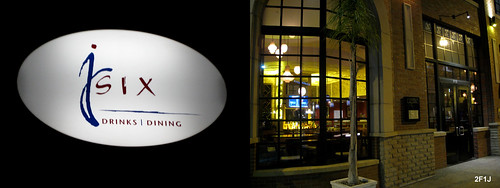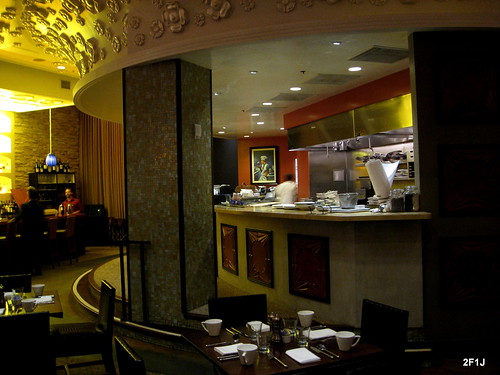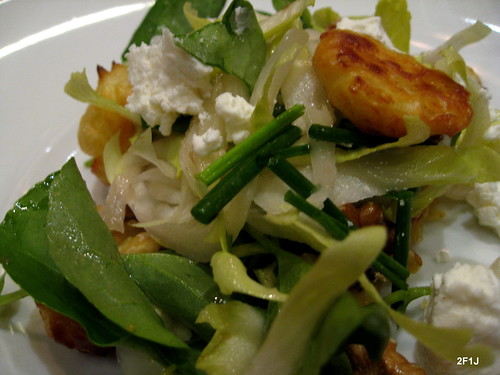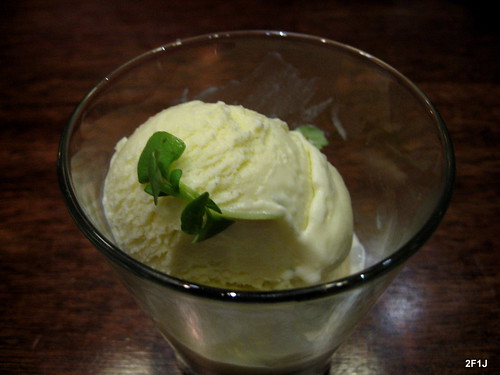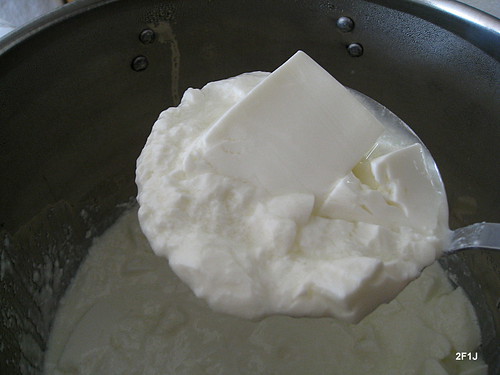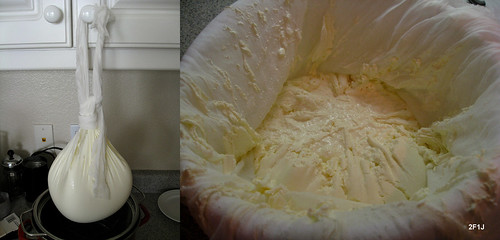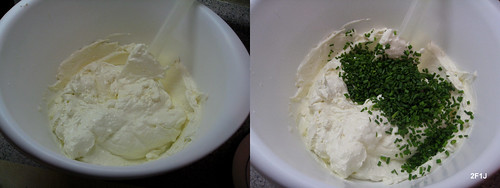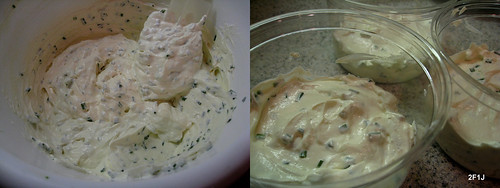Hotel restaurants are often places we try to avoid. They tend to be synonyms for all things we don’t like about restaurants – large, low quality food, boring menus, and often impersonal, stressed, inattentive servers. But of course there are always exceptions to the rules. One boutique hotel chain we have visited frequently in the last few years is Kimpton Hotels. Not only are we normally quite pleased with their rooms and service but they tend to have surprisingly good restaurants.
We had so far dined at Fifth Floor at the Hotel Palomar in San Francisco where Chef Jennie Lorenzo is able to create an interesting California-French cuisine and at Blvd 16 at the Hotel Palomar in Los Angeles/Westwood. At Blvd 16 Chef Simon Dolinky has a market-driven, seasonal approach to his cooking using mainly local ingredients including herbs from his own rooftop organic herb garden. This strong emphasis on local and seasonal ingredients doesn’t come as a surprise because before heading the kitchen at Blvd 16 Chef Dolinky worked as sous chef under Christan Graves at JSix at the Hotel Solamar, the San Diego branch of the Kimpton boutique hotel chain.
Christian Graves has made an impression in the San Diego restaurant scene as a chef who is a strong believer in using local, seasonal produce, organic meats and “boat-to-pan” seafood following the “seafood watch list”. As a supporter of starting from scratch cooking and working together with local farmers he sums up his cooking style as “…the food that we do should be fairly simple in concept and not totally overdone. I very much believe in slow food, in doing artisanal cooking, in using interesting ingredients“. Chef Graves developed his interest in cooking once he moved with his family to San Francisco. After visiting cooking school he refined his cooking skills and developed his own cooking style by working in several highly acclaimed restaurants in San Francisco under well-known chefs as Bradley Ogden (One Market), Aqua (Michael Mina) and especially for five years at Farallon under Mark Franz.
We had samples of Chef Graves cooking skills at different occasions, like Cooks Confab and Chef Celebration so far and always enjoyed his philosophy of simplicity and focus on seasonality. Recently we finally decided to visit JSix itself and give Chef Graves’ five-course menu a try.
JSix is located in the ground floor of Hotel Solamar at the corner of 6th and J St in a brickstone like building.
The front part of the room is occupied by the bar whereas the back of the room houses the restaurant which has a smaller number of tables and booths than we had expected of a hotel. The restaurant has a very open design which makes it not really favorable for a romantic night but is none the less cozy.
The open kitchen acts as the central point of the restaurant.
All the bread is made fresh in-house and makes it one of the best bread baskets in San Diego. The accompanying tapenade prepared with black kalamata olives, olive oil, sundried tomatoes and anchovies was intense tasting and quite addictive.
1st Course: Endive salad with goat cheese, walnuts and cheese croutons. Very good tasting endive from Suzie’s Farms with was matched by not too mild goat cheese and fresh walnuts. The vinaigrette was light but still prominent enough to support the other ingredients. A seemingly simple dish - which was a good example of how the right balance can be found so that all the key ingredients shine. Paired wine: Martin Codax, Albarino, 2006, Spain – good balance between body and acidity with rich flavors of peach, apricot, melon and light lemon zest.
2nd Course: Black cod, arugula, grape tomatoes, bread salad, bacon, beurre blanc. JSix’s take on a simplified panzanella. Similar to the first course very fresh tasting arugula and grape tomatoes with bacon bits but the focus of the dish was the perfectly prepared black cod – moist, flakey and rich tasting. The light citrusy sauce helped to support the springlike character of the dish. Paired wine: Elizabeth Spencer, Sauvignon Blanc, 2008, France – refreshing, crisp wine with strong notes of melon, passionfruit and citrus.
3rd Course: House-made wild mushroom ricotta ravioli, snow peas, fava beans, grape tomatoes, balsamic brown butter. Very good, freshly made pasta with a strong flavored mushroom filling. As a continuous theme throughout the tasting menu this dish also had very fresh and perfectly prepared vegetables which always seemed to support the flavor of the main ingredient of the respective dish. The balsamic brown butter sauce gave an acid counterbalance to the substantial ravioli. Paired wine: Chateau Bonnet, Bordeaux Blanc, 2008, France – crisp and acidic wine with notes of citrus, apple, grapefruit.
4th Course: Grilled poussin, fingerling potatoes, asparagus, tomatoes, beurre blanc. This dish was a good showcase for excellent grilling skills. The very moist poussin, fingerling potatoes and asparagus had a nice grilling, smokey taste which didn’t overwhelm the delicate nature of the ingredients. Paired wine: Trefethen, Double T, Bordeaux Blend, 2007, Napa – mixture of mainly Cabernet Sauvignon with Merlot, Cabernet Franc, Malbec and Petit Verdot. Flavors of blackberry and raspberry with a rich, long finish.
5th Course: Trio of desserts – Banana split with bruleed bananas, vanilla macerated berries and white chocolate - basil gelato. The dessert followed the theme of the night – creative dishes focusing on few, high quality ingredients. The banana split got an interesting textural spin by the bruleed bananas. The wonderful fresh flavor of the local berries got elevated to perfection by the hint of vanilla aroma. But the true highlight of the dessert for us was the white chocolate – basil gelato. First we were a bit skeptical about this flavor combination but we were proven wrong. Like two shifted waves you first taste a white chocolate flavor, after a few seconds a stronger basil flavor takes over and then both flavors slowly start to merge into one addictive flavor. One of the best gelato’s we had in a very long time. Paired wine: Chateau Liot, Barsac, Sauternes, France – not overly sweet with tones of pineapple.
When we discussed with our waiter about the tasting menu at the end of the night we mentioned how much we liked the white chocolate - basil gelato. A few minutes later he came back with two extra scoops. We were very, very happy…
Many chefs describe their cooking style as seasonal and market-driven but once you experience their tasting menus you often find only few seasonal ingredients. It is very refreshing to sample a tasting menu where the chef takes the meaning of seasonality and local serious throughout the whole night. We found it a strong statement when two out of four savory courses were vegetarian dishes showcasing local, seasonal produce. Chef Graves has a great skill of creating simple, as in few ingredients, but elegant dishes. He has a very good ability to balance his creations so that all ingredients can show their natural flavors but at the same time grow together to a dish which is better than the sum of its parts. The front of the house holds the same high standards as the kitchen. The typical laid back San Diego style is paired with professionalism, knowledge and interest in the food. It’s often the small details which distinguish good service from mediocre. When we had questions about sources of their ingredients our waiter was very knowledgeable. We asked at the beginning if they could serve the tasting European-style, also known as slow. Our waiter made sure throughout the evening that the pacing was perfect and we enjoyed a wonderful relaxing 3.5 hours dinner.
It is surprising that when people talk about great restaurants in downtown San Diego only Cafe Chloe and Cowboy Star come up (which we both like a lot, especially our “second home” Cafe Chloe) whereas JSix rarely gets mentioned. JSix is easily on the same level as these restaurants and Chef Graves deserves much more credit for his excellence. We are looking forward to visit JSix again and to follow Chef Graves on his journey through the “seasons” of San Diego.
616 J Street
San Diego, CA 92101(619) 531-8744
